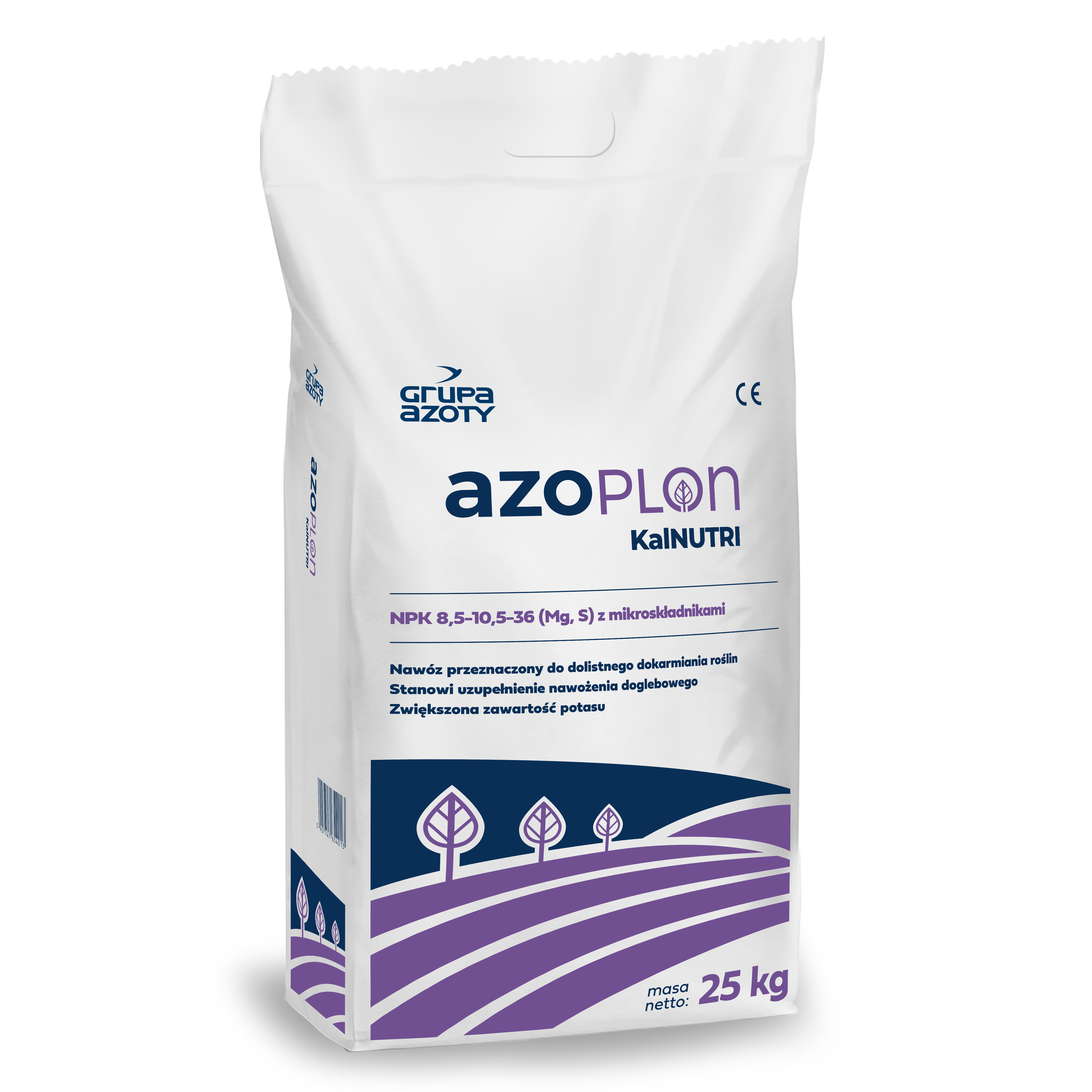
AZOPLON KalNUTRI is a multi-component, completely water-soluble, chlorine-free crystalline fertilizer with increased potassium content with an addition of magnesium, sulphyr and a complete set of EDTA chelate micronutrients. A fertilizer for foliar feeding of most crops, orchards and vegetables. Recommended for use during periods of increased demand for potassium, mainly in the stages of intensive growth as well as flowering and shaping of the crop. Due to the high content of potassium, the fertilizer provides dynamic growth, increased resistance to low an high temperatures, proper fruit colouring and increased protein, sugar (starch) and fat content in plants.
For foliar application, it is recommended to spray with a solution of appropriate concentration. Foliar treatments should not be performed during hot and sunny weather, at extremely low or high temperatures, and on plants with wilting symptoms.
| Nutrients | % (m/m) |
| Total nitrogen (N) | 8.5 |
| Nitrate nitrogen (N-NO3) | 8.5 |
| Phosphorus pentoxide (P2O5) | 10.5 |
| Potassium oxide (K2O) | 36 |
| Magnesium oxide (MgO) | 2.5 |
| Sulphur trioxide (SO3) | 6.25 |
| Boron (B) | 0.02 |
| Copper (Cu) (EDTA) | 0.05 |
| Iron (Fe) (EDTA) | 0.05 |
| Manganese (Mn) (EDTA) | 0.01 |
| Molybdenum (Mo) | 0.001 |
| Zinc (Zn) (EDTA) | 0.03 |




Thanks to advancing specialization on the NPK fertilizer market a farmer is able to easily purchase a product with a composition specially selected for a specific crop, at a specific stage of its development. This eliminates the need to additionally calculate application rate and purchase supplementing agents.

| Crop | Application time | Application rate (kg/ha) | Recommended number of applications | Recommended quantity of spray liquid (l/ha) |
| FIELD CROPS | ||||
| Cereals | Tillering, first node to the flag leaf, beginning of heading | 2 – 4 | 1 – 3 | 200 – 300 |
| Oilseed rape | 4-8 leaves unfolded, inflorescence emergence, early pod development | 2 – 4 | 1 – 3 | 200 – 300 |
| Maize | 3-6 leaves unfolded, 8-10 leaves unfolded | 2 – 4 | 1 – 2 | 200 – 300 |
| Sunflower | Beginning of stem elongation | 2 – 4 | 1 | 200 – 300 |
| Potato | Crop cover, 20-30% of total final tuber mass reached, 40% of total final tuber mass reached, 50-60% of total final tuber mass reached, 70% of total final tuber mass reached, 80-90% of total final tuber mass reached | 2 – 4 | 2 – 6 | 200 – 300 |
| Soybean | First petals visible, development of pods and seeds | 2 – 4 | 1 | 200 – 300 |
| Flax | Main stem growth, first flower buds visible | 2 – 4 | 1 | 200 – 300 |
| Other | First flower buds visible | 02.kwi | 2 – 3 times every, 10 – 4 days | 200 – 300 |
| ORCHARDS | ||||
| Stone-fruit trees: sour cherry, cherry, plum, peach, apricot | Fruit growth, maturity of fruit | 3 | 01.lut | 500 – 800 |
| Pome-fruit trees: apple tree, pear tree | Fruit growth | 3 | 1 | 500 – 800 |
| Fruit growth | 3 | 2 applications every 7 – 10 days | 500 – 800 | |
| Berry plants: raspberry, blackberry, currant,blueberry, strawberry | Fruit growth, maturity of fruit | 3 | 1 | 500 – 800 |
| VEGETABLES feeding to stimulate plant growth | ||||
| Solanaceous vegetables: tomato, pepper, eggplant | Development and ripening of fruits | 3 | 3 times every 2 weeks | 300 – 500 |
| Bulb vegetables: onion, leek, garlic | Bulb begins to extend | 3 | 2 times every 2 weeks | 300 – 500 |
| Root vegetables: carrot, parsley, celery, beetroot | 10 leaves unfolded | 3 | 2 times every 2 weeks | 300 – 500 |
| Leafy vegetables: headed cabbage, cauliflower, broccoli, kohlrabi, radish, kale | 20-30% of the expected head size reached | 3 | 3 times every week | 300 – 500 |
| Cucurbits: pumpkin, cucumber, zucchini | Fruit development | 3 | 1 | 300 – 500 |
| Legumes: peas, beans | 10% of pods have reachedtypical length | 3 | 1 | 300 – 500 |
| Other | In case of deficiency | 2 – 4 | 2 – 3 times every, 10 – 14 days | 300 – 500 |
| FERTIGATION | ||||
| Vegetable seedling | 0.3 – 1 kg per 1000 l of water | 0.03 – 0.1 | ||
| Orchards | 0.3 – 1 kg per 1000 l of water | 0.03 – 0.1 | ||
| Berry plants | 0.3 – 1 kg per 1000 l of water | 0.03 – 0.1 | ||
| Orchard plants | 0.3 – 1 kg per 1000 l of water | 0.03 – 0.1 | ||
| Nurseries of annual ornamental plants | 0.3 – 1 kg per 1000 l of water | 0.03 – 0.1 | ||
| Nurseries of perennial ornamental plants | 0.3 – 1 kg per 1000 l of water | 0.03 – 0.1 | ||
Hazard statements:
H319: Causes eye irritation.
Precautionary statements:
P264: Wash hands thoroughly after handling.
P280: Wear protective gloves/protective clothing/eye protection/face protection.
P305 +P351 + P338: IF IN EYES: Rinse cautiously with water for several minutes. Remove contact lenses if
present and easy to do. Continue rinsing.
P337+P313: If eye irritation persists: Get medical advice/attention.
